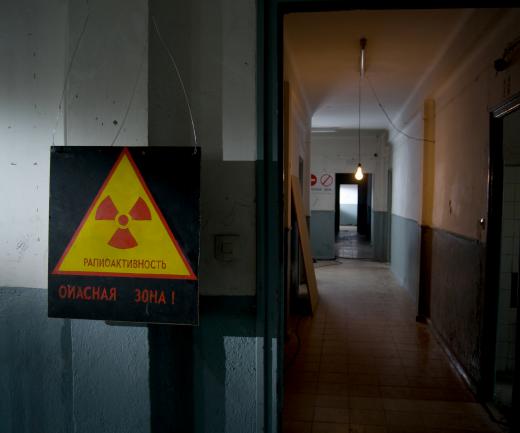What is Cesium?
 Mary McMahon
Mary McMahon
Cesium is a rare metallic chemical element that is used in an assortment of industries. It also has a wide range of isotopes, many of which are radioactive. Since it is highly reactive, the element is not usually found in a pure form in nature; most of the world's supply comes from minerals and nuclear fission. Consumers do not generally interact directly with cesium or its isotopes, although they may own products which contain it as a component.
In appearance, cesium is soft and silvery white. It has the unusual property of being liquid at room temperature. The element is also extremely reactive, highly alkaline, and very electropositive. Cesium can react violently with water, ice, or moist air. It is identified with the symbol Cs on the periodic table of elements, and it has an atomic number of 55. The high reactivity of this element means that it appears in a number of compounds, some of which are toxic.

The discovery of cesium is credited to Gustav Kirchoff and Robert Bunsen in 1860. Using a spectrometer to analyze mineral water from Durkheim, Germany, the two men noted the existence of a previously unidentified element that emitted a distinctive bluish gray line on the spectrum. The men named the element after the Latin caesius, which means "bluish gray." By 1882, another chemist had managed to isolate metallic cesium. Writers of British English may be more familiar with the element as caesium.

In industry, cesium is used in atomic clocks, photoelectric cells, and in nuclear medicine. Some radioactive isotopes appear to be highly useful in cancer treatment. The element is also used as a catalyst to create certain desired chemical reactions, and it is used in various fields of scientific research. Compounds are available at fairly reasonable prices; in its pure form, itcan be quite expensive.
Radioactive cesium isotopes can enter the environment through the detonation of nuclear devices and through improperly controlled waste. These isotopes can permeate drinking water and rivers, potentially causing human health effects ranging from spasms to death, depending on the extent of exposure. Fortunately, cesium poisoning appears to be fairly rare, since a high concentration is required for toxicity to be reached. However, care should be used when handling the element and its isotopes because of its reactivity and toxicity.
AS FEATURED ON:
AS FEATURED ON:












Discussion Comments
This information was very useful. Cesium is now my favorite element in the periodic table!
@anon157664 – Technically, you’re right on both accounts. Cesium is an Alkali Metal, which is defined as a highly reactive metal that doesn’t normally occur in nature. So yes, it’s a metal.
The author of the article probably wrote that Cesium is liquid at room temperature because the Cesium is in its liquid state at a rather low temperature: 83.3 degrees Fahrenheit.
For scientific purposes, “room temperature” is 72 degrees Fahrenheit. I’ve also seen it list as 73 degrees, but never as high as Cesium’s melting point. So yes, by scientific standards, Cesium is a solid at room temperature.
But I thought that Cesium was a metal and at room temperature it was a solid.
i think this was useful.
Post your comments